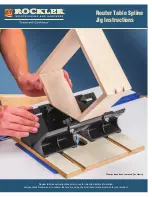
13.3
Restart protection
If the power cable plug is plugged in with the tool
switched ON or the power restored after a power
failure, the wall chaser will not start. The red
electronic signal indicator (6) flashes. Switch tool
off, then on again.
14 Motor cleaning
External
To prevent stone-dust build-up inside the wall
chaser when used over extended periods, the
motor needs to be cleaned periodically by blowing
out with compressed air (through the vent slot at
the rear end of the motor casing). This should not
be done indoors.
15 Carbon brushes
When the brushes of the wall chaser are worn
beyond a certain limit, their built-in automatic
tripping device breaks the circuit and the tool
stops running.
The brushes should be replaced in the factory or
by a suitably equipped service centre. At the same
time the tool can be throroughly checked and the
motor cleaned.
16 Repairs
Repairs to electrical tools must be
carried out by qualified electricians
ONLY!
If you have Metabo electrical tools that require
repairs, please contact your Metabo service
centre. For addresses see www.metabo.com.
You can download spare parts lists from
www.metabo.com.
17 Protection of the
environment
The sanding dust generated may contain
hazardous materials: do not dispose of with the
household waste, but at a special collection point
for hazardous waste.
Observe national regulations on environmentally
compatible disposal and on the recycling of
disused machines, packaging and accessories.
Only for EU countries: Never dispose of
power tools in your household waste! In
accordance with European Guideline
2002/96/EC on used electronic and
electric equipment and its implementation in
national legal systems, used power tools must be
collected separately and handed in for
environmentally compatible recycling.
18 Technical specifications
Explanatory notes on the information on page 3.
Changes due to technological progress reserved.
D
= Diamond cutting blade diameter
B
= Possible chase widths
T
= Depth of cut, adjustable
P
1
= Rated input
P
2
= Rated output
n
= Rated speed
m
= Weight
Vibration total value (vector sum of three
directions) determined in accordance with
EN 60745:
a
h
= Vibration emission value
K
h
= Uncertainty (vibration)
The vibration emission level given in this
information sheet has been measured in
accordance with a standardised test given in
EN 60745 and may be used to compare one tool
with another. It may be used for a preliminary
assessment of exposure.
The declared vibration emission level represents
the main applications of the tool. However if the
tool is used for different applications, with different
accessories or poorly maintained, the vibration
emission may differ. This may significantly
increase the exposure level over the total working
period.
An estimation of the level of exposure to vibration
should also take into account the times when the
tool is switched off or when it is running but not
actually doing the job. This may significantly
reduce the exposure level over the total working
period.
Identify additional safety measures to protect the
operator from the effects of vibration such as:
maintain the tool and the accessories, keep the
hands warm, organisation of work patterns.
Typical A effective perceived sound levels:
L
pA
= Sound pressure level
L
WA
= Acoustic power level
K
pA
/
WA
= Uncertainty (sound level)
During operation the noise level can exceed
85 dB(A).
Wear ear protectors!
18
ENGLISH
















































